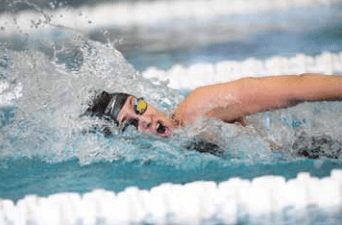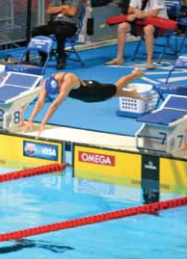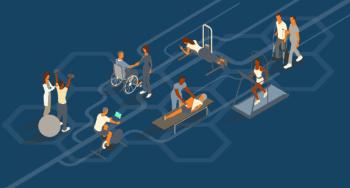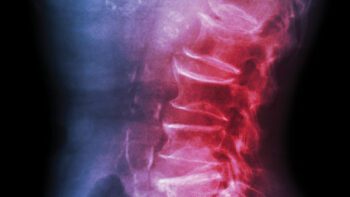
As a collegiate swimmer at Virginia Tech, my physical health was crucial to my success in the pool as well as in the classroom. During the fall of my junior year, I began noticing low back pain as a result of prolonged sitting through classes. I had to constantly readjust my posture while sitting because of the discomfort I was experiencing. As my back pain became increasingly unbearable, my performance at practices was also affected. I had a demanding weekly training schedule of nine swimming practices, two dry land workouts, and three lifting sessions; after two months of pain, I knew I had to get my back evaluated.
The first step I took in November of 2011 was to visit the doctors within our athletic department. My team physician ordered some x-rays and sent me to a spine specialist in Blacksburg, VA. I had an MRI of my lumbar spine completed just before winter break. The results came after I had already traveled back home for Christmas; I had two herniated discs. The doctors suggested I head back to Blacksburg to receive an injection before our swimming team’s annual training trip. December is a crucial training period for swimmers and I hoped to receive some relief from the pain to participate in the team trip. However, the injections were ineffective, and I was unable to work out during the entire trip.

After I got back home, there was about a week before spring semester classes began. In the meantime, my neighborhood friend had referred my parents to Dr. Schuler. I immediately made an appointment at the Virginia Spine Institute before heading back to school. Once I stepped into VSI I knew I was going to be taken care of and in good hands.
“Emily came into our office as a 20 year-old collegiate swimmer from Virginia Tech who had been suffering from back pain for months. Especially for our young athletes, we like to approach spine care with non-operative measures first and foremost,” noted Thao Allen, PA-C at the Virginia Spine Institute after her first visit with Emily in January, 2012. “Our primary objective with Emily was to treat her symptoms so she could return to competitive swimming. It is standard to have athletes suspend participation in their sports to reduce symptoms; so unfortunately, Emily was advised to discontinue swimming and focus on physical therapy and the foundation of spinal health – core stabilization, strengthening, and aerobic conditioning. Dr. Schuler and I discussed with Emily and her family that we always exhaust all non-operative treatment before surgery is considered. After rounds of physical therapy and medications, Emily was not having the symptom relief we all hoped for; we added injections next.”
After these interventions, I returned to school, but I was unable to redshirt, which meant I could not suspend my status as a collegiate athlete in order to elongate my competitive eligibility. I adjusted my goals to be able to compete senior year. I came home in May and was frustrated that I was still in pain, so I scheduled another appointment with Dr. Schuler.
“Emily did not respond to the therapy and injections, so she underwent a procedure called a discography” Dr. Schuler recalls. “This test helps us receive information on whether her discs are the cause of her pain and helps us determine if she is a candidate for surgery. Our decision making reviewed Emily’s ongoing history, a physical examination, diagnostic imaging, her response to previous treatments, and the results of the discography. We recommended an anterior lumbar fusion surgery, which is a minimally invasive technique that would optimize her recovery with the goal to return her to swimming.”
After discussing surgery with my parents and doing some personal research on the surgical procedure, I decided to give it a go.
“Emily did extremely well after surgery and had a great support group – her family. She started physical therapy the day after surgery by walking the halls of the hospital, and she went home the next day after that,” Thao commented.
After surgery I was able to swim competitively for all of my senior year at Virginia Tech. Prolonged sitting no longer caused pain. It has been a little more than one year after surgery and I am able to run, bike, and do any other activities pain-free. My advice to anyone suffering from back or neck pain is to seek treatment immediately. Your neck and back health are crucial for your entire lifetime. VSI is uniquely exceptional because of its comprehensive care. The clinic, the pain management center, and the Virginia Therapy & Fitness Center are all under one roof. Overall, I had an amazing experience with VSI! I was so impressed with the quality of service and care I received as a patient, that I applied for a job as a medical assistant with VSI. Today, I am a VSI employee and am able to help people who are going through the same type of pain I went through.
Dr. Schuler and Thao were inspired by Emily’s story. “Emily went on to compete in the swimming pre-Olympic trials after her lumbar fusion surgery, making her a primary example of a true Spinal Champion®! We are proud to share her exceptional story of success through determination and devotion to her passion of swimming.”
Read more stories likes this one in the archives of our Spine Health Journal.

by Thomas C. Schuler, M.D.,
F.A.C.S.

by Thao Allen, PA-C, M.P.A.S


